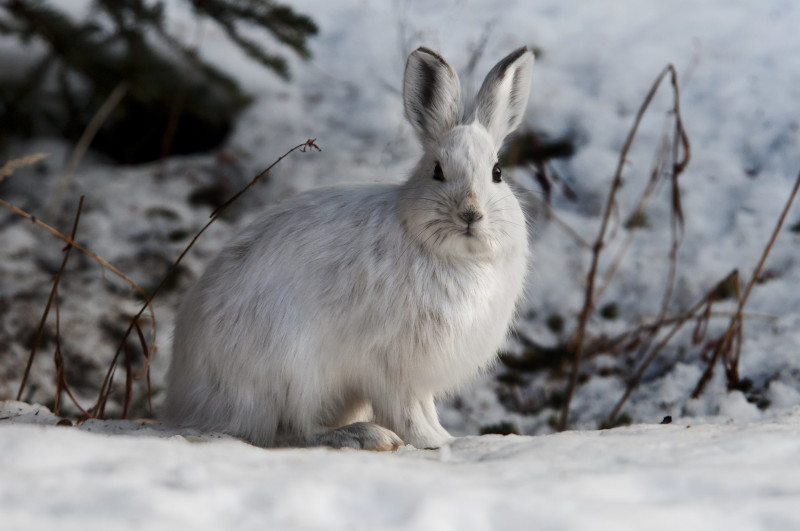Snowshoe Hare Facts
- This beautiful small mammal is most frequently referred to by the appealing common name of the Snowshoe Hare. Yet, it also has several other, alternate names that it’s known by. Though less often used, it’s sometimes called either the showshoe rabbit or else the varying hare.
- Among scientific professionals, however, such as researchers, it’s typically referred to by its formal name. Thankfully for us, that’s a relatively simple term, as such things go. That’s because the delightful animal also bears the technical name of Lepus americanus.
- It received that technical name due to the work of the respected German naturalist, Johann Christian Polycarp Erxleben. That researcher made the first acknowledgement of it as a separate and distinct species. He accomplished this noteworthy deed in the year 1777.
- Regardless of which term one uses to refer to it, though, the wonder remains an intriguing animal. In addition to its sheer visual appeal, it holds a scientific interest in certain circles. In fact, due to aspects of its ecology, it’s a frequent subject of study of biology students.
- Fortunately, for the moment the population of the Snowshoe Hare still appears to be holding steady, and at sufficient numbers. This further seems to hold true throughout the entirety of its territory. The IUCN, therefore, presently lists it as Least Concern on its published Red List.
- The awesome animal nevertheless does presently face several potential threats, at least. Habitat degradation, or outright loss, due to human acttivites poses a possible future threat. Its greatest threat, however, most likely comes from the effects of ongoing climate change.
Related Articles
Pygmy Rabbit
Snowshoe Hare Physical Description
The remarkable Showshoe Hare easily captivates those individuals fortunate enough to encounter it. The animal does so, however, due more to its pure appearance, than because of physical size. That’s because, like most of its numerous relatives, it remains a comparatively small variety of mammal.
It also displays a small degree of the physiological characteristic of sexual dimorphism. The small leporid further does so in terms of simple size. Once again following the evolutionary pattern common to its kind, the male of the species averages a slightly maller size than the female.
Overall, however, fully mature individuals generally reach a total length that measures between 16. 3 – 20.4 in (41.3 – 51.8 cm). The amazing animal’s tail also develops as relatively short, though. This small appendage, in fact, only contributes about 1.5 – 2.05 in (3.9 – 5.2 cm) to that length.
The hind feet of the creature also develop as extremely long, relative to body length. In this, the mammal stands out even among its kindred. These average between 4.6 – 5.8 in ( 11.7 -14.7 cm) long. Each of these also evolved as comparatively quite broad, forming the source of the name.
Despite the slight difference it size, individuals of the aptly-named Snowshoe Hare appear virtually identical. This trait also extends to the pattern of coloring. In this, too, it stands out from many mammals, though. That’s true since its colors vary significantly, according to the seasons.
During the summer, the basic colors consist of combinations of rusty-red and grayish brown. It also presents a whitish stomach, along with a cinnamon shade on the face and legs. But during the winter, this pattern alters significantly. During that period, it becomes almost entirely white.
- Kingdom: Animalia
- Phylum: Chordata
- Class: Mammalia
- Order: Lagomorpha
- Family: Leporidae
- Genus: Lepus
- Species: L. americanus
Snowshoe Hare Distribution, Habitat, and Ecology
Fortunately, the gorgeous Snowshoe Hare evolved as endemic to a relatively broad swathe of the globe. That’s due to the fact that it appears natively across a respectable portion of North America. Yet, that territorial range only includes a portion of the northerly sections of the continent.
More precisely, however, the animal only lives in parts of Canada and the United States. The vast majority of its indigenous territory lies within the confines of Canada, though. There, the animal lives throughout most of the country, from Newfoundland in the east, all the way to the west coast.
Yet, within the United States, that territorial range is broken and widely scattered. Outside the contiguous part of that country, it also inhabits most of Alaska. Within those borders, though, it appears in central California, the Rocky Mountains, southern Utah, and the Appalachian Mountains.
In all regions it appears in, however, the animal displays decided preferences for its choice of habitat. Although individual exceptions do occur, of course, the majority appear in one of two types of ecosystems. These consist solely of boreal forests or higher regions of montane forests.
In both types of habitat, however, the beautiful small animal prefers the presence of dense areas of shrub. This serves the dual purpose of protection from predators, and a ready source of food. It consumes green vegetation during the warm months, and bark, twigs, and needles in winter.
Regrettably, the Snowshoe Hare serves as prey for a variety of predators. The Canadian Lynx forms its primary threat, in that regard. Other enemies, however, include bobcats, martens, weasels, wolves, cougars, and black bears. Even a few domestic cats and dogs sometimes prey on it.
Species Sharing Its Range
Hines Emerald Dragonfly
Check out our other articles on 5 Magnificent Mammals of Argentina, Petra Iris, Mount Kinabalu, New Guinea Crocodile, Asian Weaver Ant, European Honey Buzzard, Wood Frog, Striped Possum

